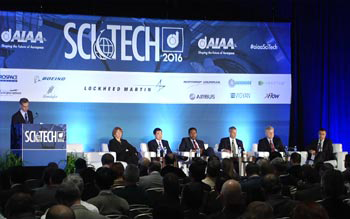Aerospace: Collaboration Makes It Soar Written 7 January 2016
Panelists: Moderator: John Tracy, chief technologist, The Boeing Company; Morteza Gharib, California Institute of Technology; Dana “Keoki” Jackson, chief technology officer, Lockheed Martin Corporation; Sandy Magnus, AIAA executive director; Darryll Pines, Dean, Clark School of Engineering, University of Maryland College Park; Jaiwon Shin, associate administrator, aeronautics research mission directorate, NASA; Steve Walker, deputy director, Defense Advanced Research Projects Agency (DARPA)
By Duane Hyland, AIAA Communications (2008–2017)

Collaboration and cooperation are critical to driving future growth in aerospace science and technology, according to a Jan. 7 panel of experts at the 2016 AIAA Science and Technology Forum and Exposition in San Diego.
The panel, “Aerospace Frontiers — Strengthening Collaboration for Continued Progress,” looked at how nexuses are built among professional, government, industry and academic organizations and how these collaborations drive growth in the industry.
Sandy Magnus, AIAA executive director, explained that professional organizations like AIAA provide a platform for the aerospace community to come together to allow the discussions to advance the industry.
“We use conferences such as this to do that,” Magnus said.
The other panelists expressed appreciation for what professional societies do and highlighted what their organizations do to promote communication and collaboration across boundaries.
Darryll Pines, Farvardin professor and dean of the A. James Clark School of Engineering at the University of Maryland, also said that now is a great time for engineering.
“Over 500,000 engineers are working in the U.S. today,” he said, stressing that platforms like conferences and professional societies are vitally important to the exchange of ideas.
The representatives of industry on the panel highlighted the importance of the academic community in providing the future workforce as well as opportunities for vital research and development partnerships.
“We need the ideas that come out of university research programs, and those are the people who will continue to generate these ideas,” said Keoki Jackson, chief technology officer at Lockheed Martin.
Each of the panelists identified the same barriers to professional growth for today’s engineers: budgets; burdensome government regulations; resistance from middle-management in industry to allow conference attendance; and a misunderstanding of the nature of science and technology conferences.
Steve Walker, deputy director of the Defense Advanced Research Projects Agency, said that one of his unique barriers is obtaining capable program managers that can leave their academic careers for two to five years to run DARPA’s programs.
Ongoing communication with lawmakers and others would eventually help erode these barriers, panelists said.
In the end, all of the panelists agreed that what AIAA and other professional societies do is extremely vital to the entire science and technology enterprise.
